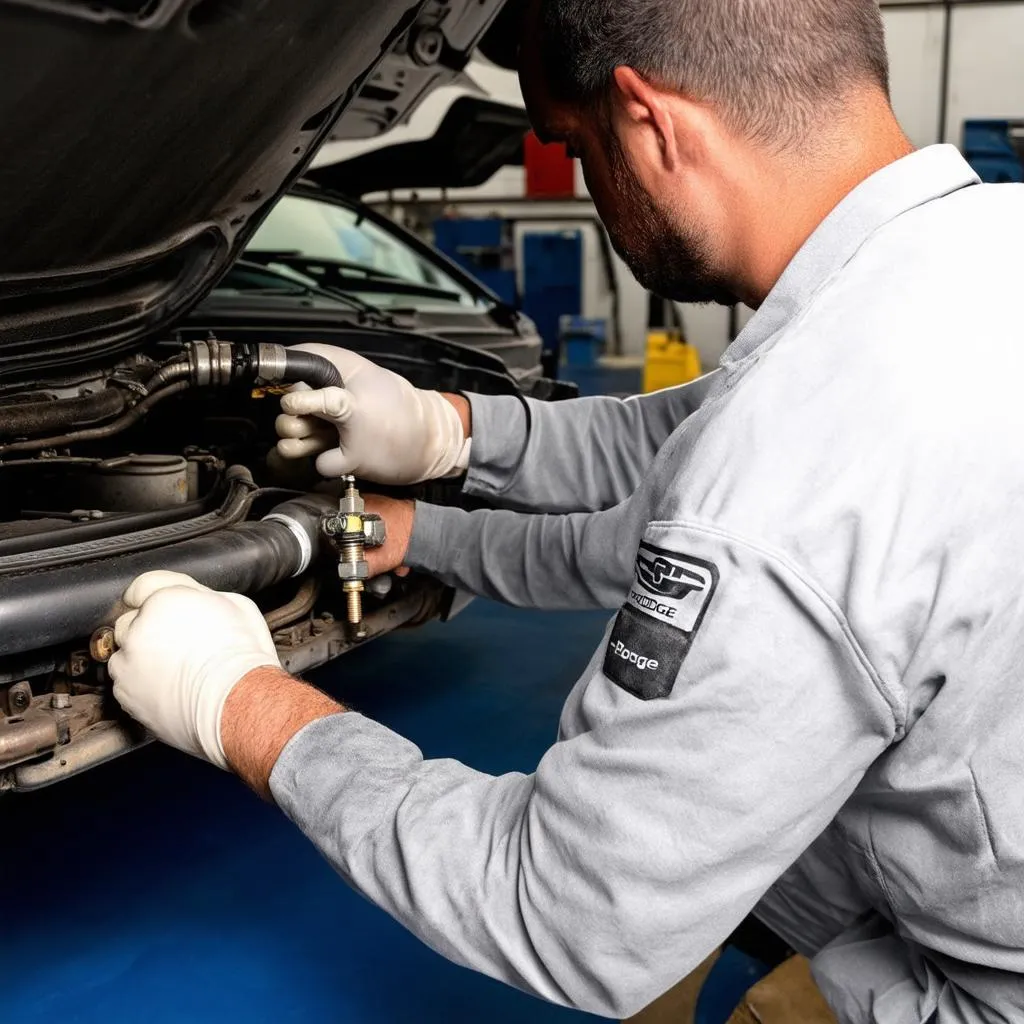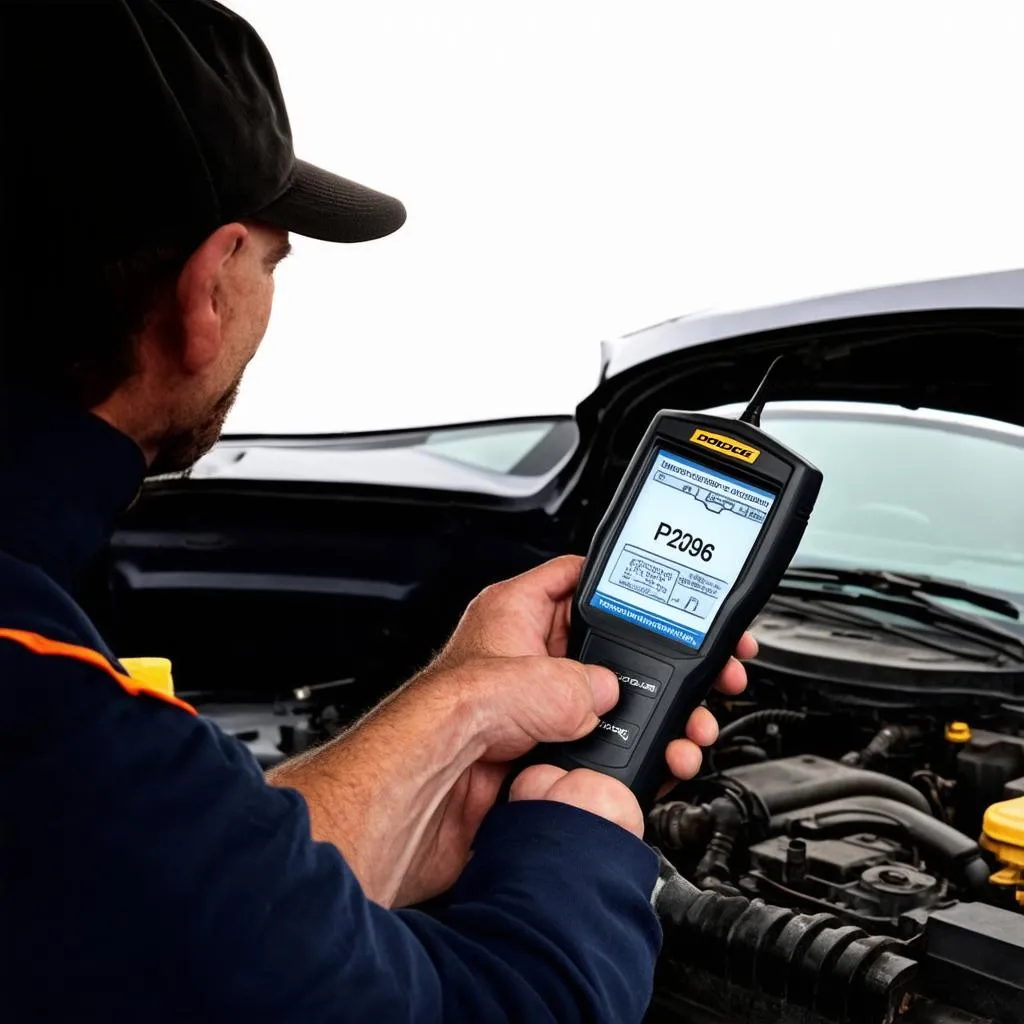Have you ever been driving your Dodge vehicle, only to have the “Check Engine” light illuminate on your dashboard? This can be a frustrating experience, especially if you’re unsure what the problem is. One common OBD code you might encounter is P2096, which indicates a problem with the post-catalyst oxygen sensor (HO2S) on Bank 1 Sensor 2.
What Does OBD Code P2096 Mean?
The OBD code P2096 is a diagnostic trouble code (DTC) that indicates a malfunction in the post-catalyst oxygen sensor on Bank 1 Sensor 2. This sensor is crucial for monitoring the exhaust gas after it has passed through the catalytic converter.
Understanding the Importance of the Post-Catalyst Oxygen Sensor
The post-catalyst oxygen sensor is like a detective, analyzing the exhaust gas after it has been cleaned by the catalytic converter. It sends information to the engine control unit (ECU) about the efficiency of the catalytic converter. If the ECU detects a problem with the catalytic converter’s performance, it will trigger a “Check Engine” light and store the P2096 code.
Common Causes of OBD Code P2096
There are several possible reasons why you might encounter the P2096 code. These include:
- Defective Oxygen Sensor: The most common cause is a faulty oxygen sensor. Over time, these sensors can become contaminated, damaged, or simply wear out.
- Catalytic Converter Issues: A damaged or clogged catalytic converter can also lead to an inaccurate reading from the oxygen sensor.
- Exhaust Leak: A leak in the exhaust system can allow unburned fuel to escape before reaching the oxygen sensor, causing it to malfunction.
- Electrical Problems: A faulty wiring harness or connection to the oxygen sensor can also trigger the P2096 code.
How to Diagnose and Fix OBD Code P2096
Once you’ve identified the P2096 code, it’s time to pinpoint the root cause and fix the issue. Here’s a step-by-step guide:
- Inspect the Oxygen Sensor: Start by visually inspecting the oxygen sensor for any signs of damage, corrosion, or loose connections. If the sensor appears damaged, it should be replaced.
- Check the Catalytic Converter: Inspect the catalytic converter for any signs of damage, such as holes, cracks, or a broken mounting bracket.
- Check for Exhaust Leaks: Look for any signs of exhaust leaks in the exhaust system, such as soot buildup, cracked pipes, or loose clamps.
- Inspect the Wiring Harness: Ensure that the wiring harness leading to the oxygen sensor is intact and free of any damage or corrosion.
- Use a Scanner: Use an OBD2 scanner to read the code and access any freeze frame data. This data can provide valuable insights into the conditions at the time the code was triggered.
Frequently Asked Questions About OBD Code P2096
What are the symptoms of P2096?
Besides the “Check Engine” light, you might experience reduced fuel efficiency, rough idling, or a decrease in engine power.
Can I drive with P2096?
It’s generally not recommended to drive with a “Check Engine” light on, as it indicates a potential problem that could worsen over time.
How much does it cost to fix P2096?
The cost of fixing P2096 can vary depending on the underlying cause. Replacing an oxygen sensor can range from $100 to $300, while repairing a catalytic converter can cost hundreds or even thousands of dollars.
Can I reset the P2096 code myself?
Yes, you can reset the code using an OBD2 scanner, but this will only temporarily clear the light. If the underlying issue isn’t resolved, the code will likely reappear.
What to Do Next
If you’re experiencing the P2096 code, it’s important to seek professional assistance from a qualified mechanic. They can diagnose the problem accurately and recommend the appropriate repair.
 Dodge Obd Code P2096: Oxygen Sensor" width="1024" height="1024">Dodge OBD Code P2096: Oxygen Sensor
Dodge Obd Code P2096: Oxygen Sensor" width="1024" height="1024">Dodge OBD Code P2096: Oxygen Sensor
Some Words of Wisdom
Many people believe that encountering certain car problems can be a sign of misfortune. Some might even turn to Feng Shui for guidance. However, it’s important to remember that car problems are often just mechanical issues that can be solved with the right knowledge and tools.
Final Thoughts
Remember, the P2096 code is just a symptom of a larger problem. Don’t ignore the “Check Engine” light, as it could signal a serious issue that needs attention. Seek professional assistance from a trusted mechanic to diagnose and resolve the problem efficiently.
If you have any further questions about OBD codes or need help diagnosing and fixing car problems, don’t hesitate to reach out to our team of experts. We’re available 24/7 to provide support and guidance.
WhatsApp: +84767531508
Don’t forget to check out these related resources on our website:
- https://techcarusa.com/2011-jeep-wrangler-unlimited-rubicon-obd-code-p2096/
- https://techcarusa.com/category/dodge/
- https://techcarusa.com/category/obd-codes/
 Dodge OBD Code P2096: Mechanic
Dodge OBD Code P2096: Mechanic
Let us know your thoughts in the comments section below and share this article with your friends who might find it helpful!